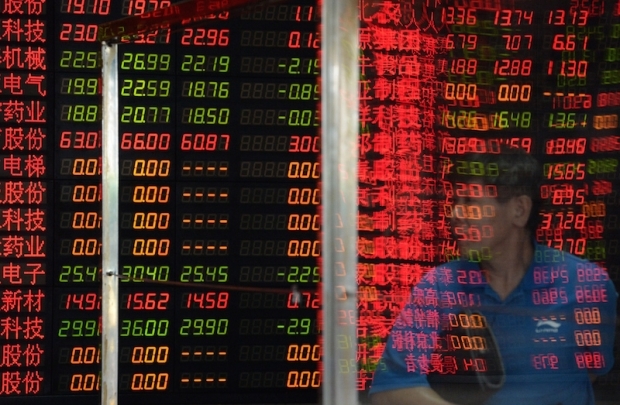Nearly two years ago China’s Communist Party released a major economic reform blueprint, whose signature phrase was that market forces would be given a “decisive role” in resource allocation. That Third Plenum Decision and other policy pronouncements raised hopes that Xi Jinping’s government would push the nation toward a more efficiency-driven growth model in which the private sector would take a greater share of economic activity and the state would exercise its leadership less through direct ownership of assets than through improved governance and regulation.
Over the past two weeks, Xi’s bureaucrats launched the most heavy-handed intervention in China’s stock markets in their twenty-five year history. Spooked by a sudden 19% plunge in the Shanghai Composite Index, regulators halted initial public offerings, suspended trading in shares accounting for 40% of market capitalization, forced state-owned brokers to promise to buy stocks until the index reached a higher level, mobilized state-controlled funds to purchase equities, and promised unlimited support from the central bank. At first these measures failed to prevent a further fall. But by the end of last week, the market stabilized, at a level 28% below its June 12 peak but still up 82% from a year ago, when the bull run started. What ever happened to the “decisive role” of market forces?
Conversation
07.02.15
How Much Does the Chinese Market Matter to the World?
A skeptic would argue that the contradiction between market-friendly rhetoric and dirigiste reality shows up the hollowness of Xi’s reform program. Under this reading, the promised economic restructuring is unlikely to make much progress, either because Xi doesn’t really believe in it, or because the power of entrenched interest groups and bad old habits is simply too great to overcome.
This view finds support in both the embarrassing stock-market spectacle and the fitful progress of reforms. Progress in a few areas has been solid: slashing of bureaucratic red tape has led to a surge in new private businesses; full liberalization of interest rates seems likely following the introduction of bank deposit insurance in May; Rmb 2 trillion (US$325 billion) of local government debt is being sensibly restructured into long-term bonds; tighter environmental regulation and more stringent resource taxes have contributed to a surprising two-year decline in China’s consumption of coal. But many other crucial reforms are missing in action. Most important, almost nothing has been done to dredge the dismal swamp of state-owned enterprises (SOEs), which deliver a return on assets only half that of private companies, but still suck up a share of national resources (capital, labor, land and energy) grossly disproportionate to their contribution to output.
Given this record, it is plausible to interpret the stock market’s wild ride over the past year as a diversionary tactic by a government facing economic growth that ground ever lower and reforms that seemed ever more stuck in the mud. First Beijing tried to pump things up by encouraging retail investors to return to a stock market they had abandoned after the last bubble burst in 2007, and let brokers extend huge amounts of credit to enable investors to double their bets on margin. By early July, margin credit stood at Rmb 2 trillion, four times as much as a year earlier. That figure equaled 18% of the “free float” value of the market (i.e. the value of all freely tradable shares, exluding those locked up in the hands of strategic long-term shareholders). Even after a recent decline, margin credit is nearly 14% of Shanghai’s free-float market capitalization, compared to less than 6% in New York and under 1% in Tokyo.
Conversation
04.16.15
How Much Consumerism Can China Afford?
The Chinese government also tried to entice foreign investors by permitting them to invest in the Shanghai market via brokers in Hong Kong. And for a while it seemed possible that domestic A-shares would be included in the MSCI Emerging Markets Index, which would have forced global institutions to move billions of dollars of equity investments to Shanghai in order to ensure their funds matched their index benchmarks. (In early June, MSCI deferred that decision for at least another year.) Amid a dearth of good economic news, the government could point to a buoyant stock market as evidence that it was doing something right. And after a couple of years spent cracking down on wealth-making activities through a fierce anti-corruption campaign, Beijing could also reassure business and financial elites that it had their interests at heart.
For a while it worked: the Shanghai index more than doubled in the 12 months before its June peak. But the ill-informed enthusiasm of novice investors, magnified by credit, pushed valuations to absurd levels that could lead only to an ugly crash. Now that the crash has come, China’s leaders must face the grim reality of a broken market, a stagnant economy, and a stalled reform program.
This account has much truth to it. The government did encourage the stock bubble, and its blundering intervention last week did undermine the credibility of its commitment to markets. Yet there is another way of looking at things that is both less dire and better attuned to China’s complexities.
Little evidence suggests that the stock market lay anywhere near the center of policy makers’ concerns, during either the boom or the crash. The main aims of macroeconomic policy over the last nine months have been to support investment growth by a cautious monetary easing, and to stabilize a weakening property market (important because construction is the key source of demand for heavy industry). The stock market was a sideshow: an accidental beneficiary of easier money, and the fortuitous recipient of funds from investors fleeing the weak property market and seeking higher returns in equities.
There was good reason for policy makers not to pay much attention to the stock market. China’s market is essentially a casino detached from fundamentals. It neither contributed much to economic growth while it was rising, nor threatened the economy when it collapsed.
In countries such as the U.S.—where about half of the population own stocks, equities make up a big chunk of household wealth, and corporations rely heavily on funds raised on the stock market—a big stock-market fall can inflict great pain on the economy by slashing household wealth and spending, and making it harder for companies to finance their investments. China is different: less than 7% of urban Chinese have any money in the market, and their equity holdings are dwarfed by their far larger investments in property, wealth management products, and bank deposits. Equity-raising accounts for less than 5% of total corporate fund-raising; bank loans and retained earnings remain by far the biggest sources of investment funds.
But hold on—if the market were really so economically irrelevant, then why did the government panic and try to prop it up with such extreme measures? It’s a fair question. One plausible answer is that the China Securities Regulatory Commission (CSRC), which oversees the market, got worried by the chaos and begged the State Council to mobilize support so that it could gain time to deal with the underlying problems, such as excessive margin borrowing. This explanation certainly seems to be the one the State Council wants people to believe. Despite its strong actions, the Council and its leader, Premier Li Keqiang, have stayed studiously silent on the stock market. The implied message is: “Okay, CSRC, we’ve stopped the bleeding and bought you some time. Now it is up to you to fix the mess and return the market to proper working order. If you fail, the blame will fall on you, not us.” If this interpretation is right, we can expect restrictions on trading and IPOs to be gradually lifted over the next several months, and rules on margin finance tightened to ensure that the next rally rests on a firmer foundation.
The episode highlights the contradictions in China’s present economic policies. Based on numerous statements and policy moves over the last 15 years, there can be no doubt that influential financial reformers want bigger and more robust capital markets—including a vibrant stock market—in order to reduce the economy’s reliance on politically-driven bank lending. Moreover, the success of proposed “mixed ownership” plan for SOE reform likely depends on having a healthy stock market, in which the state shareholding in big companies can be gradually diluted by selling off stakes to private investors.
But the financial reformers are not the only game in town. As analysts like me should have taken more care to emphasize when it was released, the Third Plenum Decision is no Thatcherite free-market manifesto. In addition to assigning a “decisive role” to market forces, it reaffirms the “dominant role” of the state sector. Like all big policy pronouncements during China’s four decades of economic reform, it is less a grand vision than an ungainly compromise between competing interests. One interest group is the financial technocrats who want a bigger role for markets in the name of more efficient and sustainable economic growth. Another consists of politicians and planners who insist on a large state role in the economy so as to maintain the Party’s grip on power, protect strategically important industries and assets, and provide a mechanism for coordination of macro-economic policies.
In short Xi and his colleagues, like all their predecessors since Deng Xiaoping, are trying to have it both ways: improve economic performance by widening the scope of markets, but guide the outcomes through direct intervention and state ownership of key actors and assets. Both elements, from the leadership’s standpoint, are necessary; the critical question is how they are balanced. Free-market fundamentalists might say such an approach is unsustainable and doomed to failure. But they have been saying that since reforms began in 1978, and so far they have been proved wrong by China’s sustained strong economic performance.
Of course the task now is tougher, since China no longer enjoys the tailwinds of favorable demographics and booming global export markets. Moreover, “market guidance” is fairly easy to pull off in physical markets such as those for agricultural commodities, industrial metals or even property, where the government can manipulate supply and demand through control of physical inventories. It is far trickier in the ether of financial markets, where transactions take nanoseconds and billions of dollars of value can vanish in the blink of an eye. Yet Beijing will doubtless keep trying to develop bigger and better capital markets, while at the same time intervening whenever those markets take an inconvenient turn. It is too early to say whether this strategy will prove successful, but one thing is for sure: we will see plenty more wild rides in the Shanghai stock market in the years to come.




